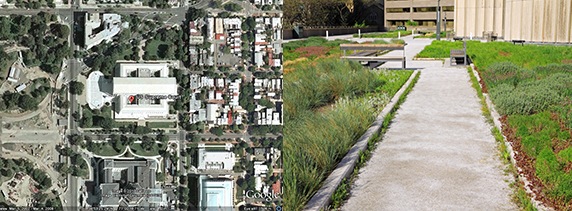White roofs can be more effective at reducing the urban heat-island effect than darker roofs and roofs covered with plants, according to a report by the Lawrence Berkeley National Laboratory. White roofs also cost less.
The report, Economic Comparison of White, Green, and Black Flat Roofs In the United States,says that white roofs are three times more effective than green roofs at “cooling the globe.” Researchers analyzed 22 commercial flat roof projects in the U.S. and performed a 50-year life cycle cost analysis.
They assumed a 20-year service life for black roofs and white roofs, and 40 years for green roofs. White roofs save $25 per square meter compared to black roofs and green roofs cost $71 per square meter more compared to black roofs, the report says.
Green roofs provide benefits that white roofs do not offer, however, such as controlling runoff and curbing air pollution.
Related Stories
Codes and Standards | Sep 15, 2021
USGBC will change leaders, conduct strategic review
Aims to ensure organization is ‘well positioned to scale its work in the post-pandemic world’.
Codes and Standards | Sep 15, 2021
LEED-certified offices earn higher rents than non-sustainable properties
Are also more resilient to dips in real estate market.
Codes and Standards | Sep 7, 2021
Boston turns to developer fees to fund flood protection infrastructure
Assessments on commercial properties will help build seawall and other protective measures.
Codes and Standards | Sep 3, 2021
Low-cost methods can have substantial impact on reducing embodied carbon
Whole-building design, material substitution, and specification strategies can slash carbon by up to 46%.
Codes and Standards | Sep 2, 2021
Case for power resiliency in buildings grows with more disaster and outages
Essential businesses like data centers, hospitals are first adopters of new storage systems.
Codes and Standards | Aug 31, 2021
UK industry group wants mandatory whole-life carbon assessments of buildings
Aims to address hidden emissions embedded in supply chains.
Codes and Standards | Aug 31, 2021
Home electrification will require code upgrades
Residential electric panel capacity must be increased.
Codes and Standards | Aug 30, 2021
Facebook’s new $800 million Arizona data center to save big on water
Will restore more than 200 million gallons of water per year to river basins.
Codes and Standards | Aug 26, 2021
California may require solar on new high-rise residential and commercial buildings
State energy commission approves proposal; Could become law in 2023.
Codes and Standards | Aug 25, 2021
Study finds racism, discrimination common in construction industry
NIBS to share best practices with industry leaders to improve worker treatment.

















